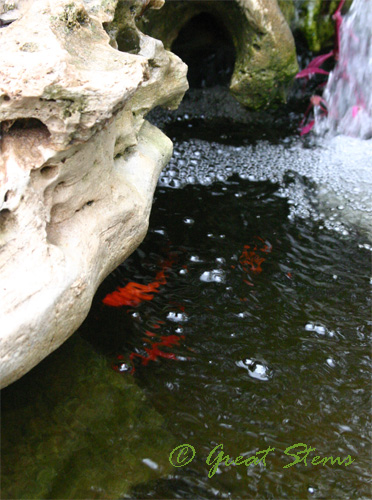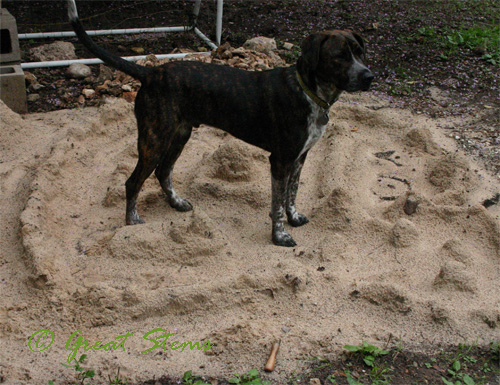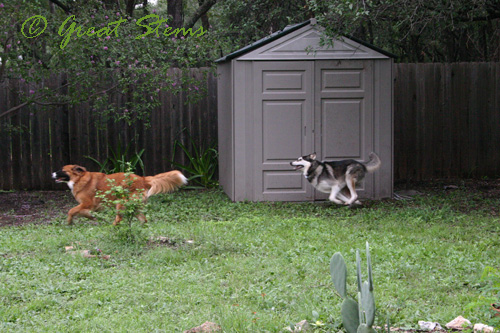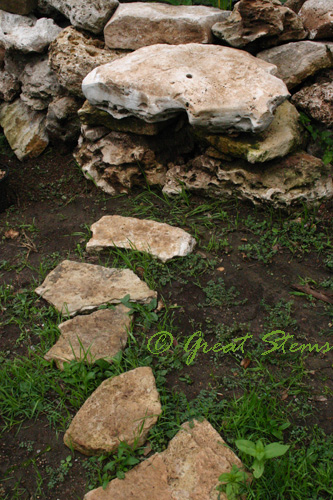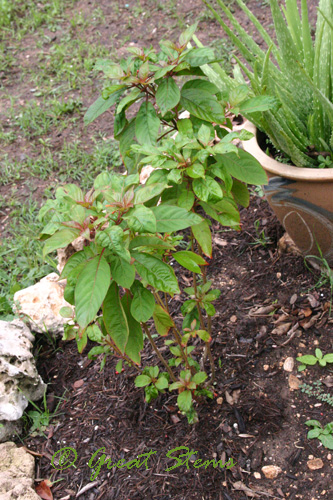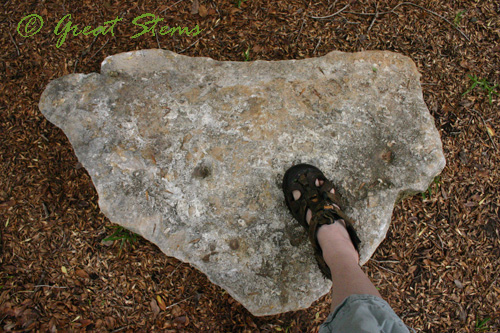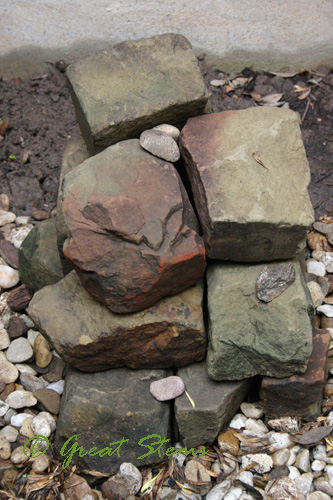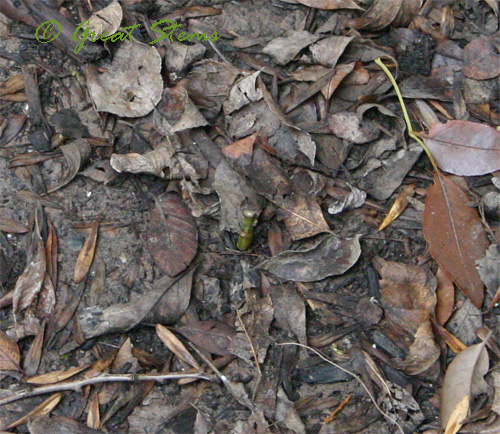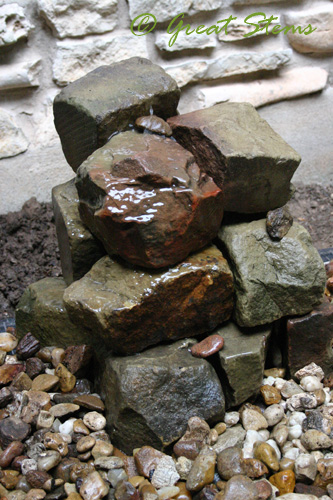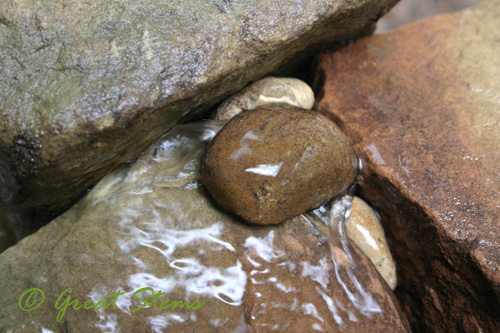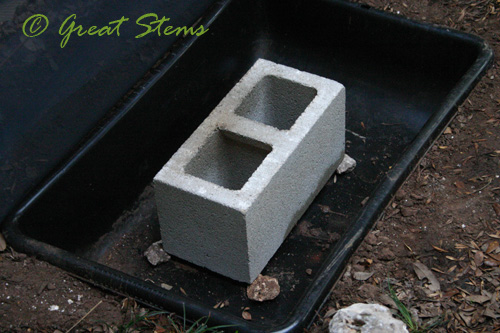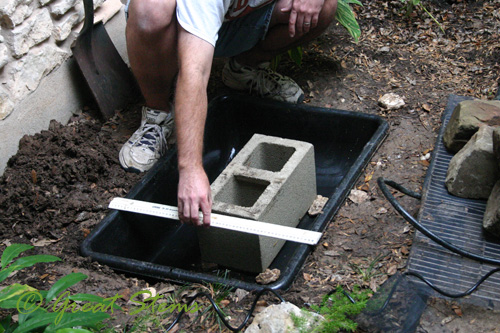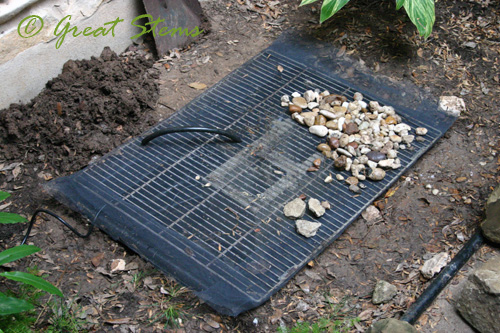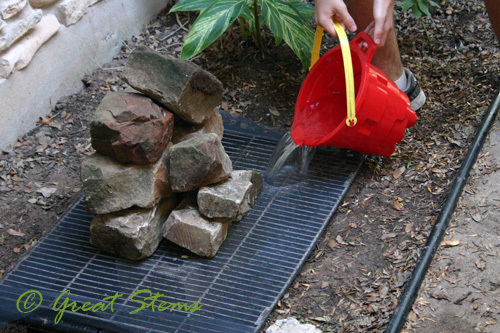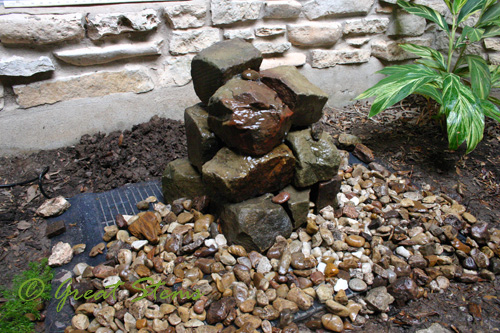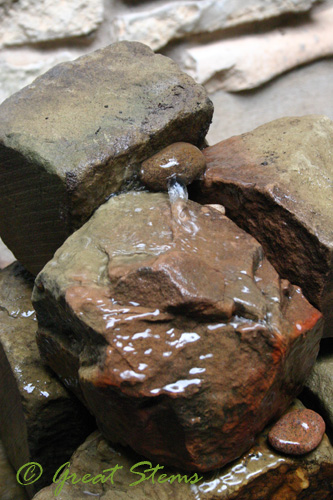Last summer, we decided to create a very inexpensive disappearing fountain for our entryway, using as many free or salvaged materials as we could. We loved the result at the time, and it cost us a total of about $40. Here’s that fountain that WAS:
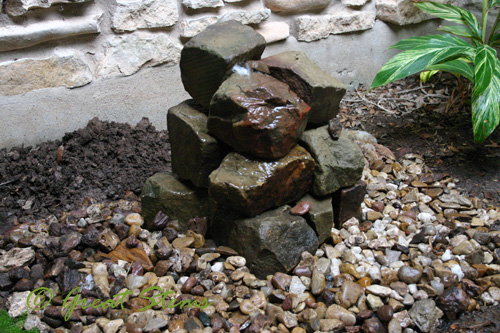
BUT…
While the fountain gave us much enjoyment for awhile, the inexpensive pump gave us some frustration. Sometimes the hose came off. Sometimes a cat or other animal would bump the rocks or hose tip, and water would drain out. Sometimes the pump would just plain stop. Everytime this happened, we had to dismantle the fountain, move the grill, get the pump going again, add more water, and rebuild the stone mountain. The little rocks were a pain to have to move and remove, too. I couldn’t buy any plants to surround the fountain, because we kept having to work with it. To top it all off, the plants that were already there all died in last winter’s hard freezes. And finally, I’d had enough. A change was in order.
We already had the basic set-up (see the link above), so I figured why not turn it into a pond instead? This way, if the pump had any more problems, access would be simple and direct. Plus, we could easily check on the level of the water, and we could support more wildlife, be it toads, dragonflies, or fish. The movement of the water would keep out the mosquitoes. And so that’s what we did.
We (and by we, I mostly mean my wonderful son) dug the hole a little deeper and slid the tub back down into it. Then we lined the tub and the hole with a leftover piece of rubber liner from our backyard pond, and collected some flagstone we’d gotten off Craigslist. The little $21 pump (130gph) we’d previously used officially died in this process, so we upgraded to a $36 pump (300gph) instead. We arranged the flagstone around the pond to hold the liner in place, as well as hide it, and then we added a few extra stones to create a simple waterfall. The rocks we had used for the previous fountain became part of the waterfall.
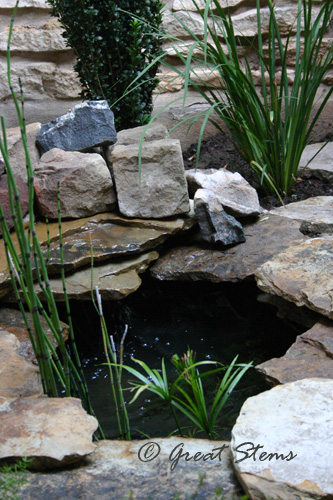
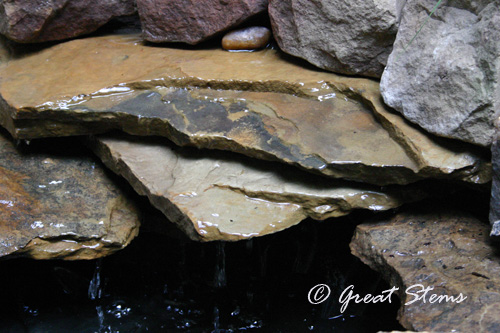 Immediately we were thrilled. This was definitely the way to go. The trickling sound of water as you walk toward our front door sets the soul at ease right away. And the flagstone complements the house nicely and ties in to the new porch we’ve been working on it (you can catch a glimpse of it in one of the photos below — it’s been one of our “secret” projects. Not so secret now! And also not officially done, but very soon.)
Immediately we were thrilled. This was definitely the way to go. The trickling sound of water as you walk toward our front door sets the soul at ease right away. And the flagstone complements the house nicely and ties in to the new porch we’ve been working on it (you can catch a glimpse of it in one of the photos below — it’s been one of our “secret” projects. Not so secret now! And also not officially done, but very soon.)
I brought some plants from the backyard pond, and finally bought new plants to complete the whole bed. We mixed in some compost to the soil before adding in the plants and then used vitamin-rich liquid seaweed to reduce their stress from being planted in July. Since it’s not a full sun area, they should be fine, despite the 100+ weather we’re having.
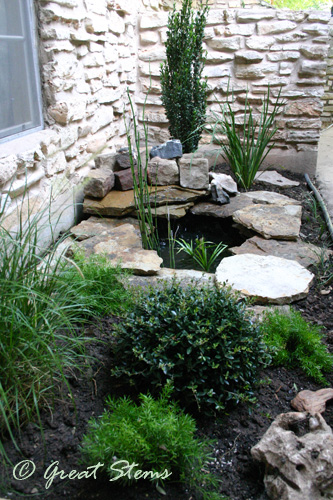
The plants I selected to surround the pond are mostly non-native. It is a tough bill to fill, that area. Mostly indirect light, with some patches of direct sun during the day — and I wanted small to medium evergreens, for the most part. Nothing could get too wide or too tall. That’s a tough list of requirements for native varieties.
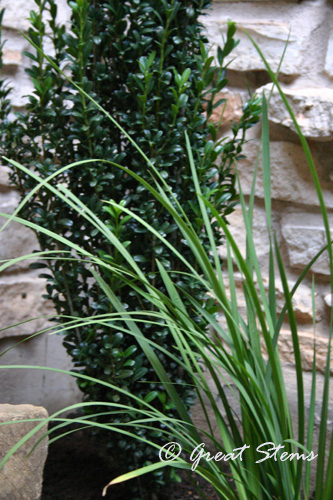
So I chose instead a Sky Pencil holly for the tallest and smallest section of the bed. It will reach about 8-10 feet tall one day but stay within 3 feet in width. Its dark green foliage is a pleasure to see, complementing the entire entryway (which has 3 beds total). Next to it is a bicolor iris. I understand that I’ll have to divide this plant periodically, but I placed it near the sidewalk for easy access. As it gets big, it will look really nice next to the waterfall.
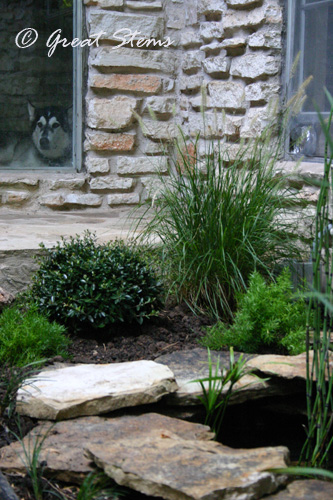
On the other side, I kept the plants smaller, because opposite them in the entryway is a very tall Yew.
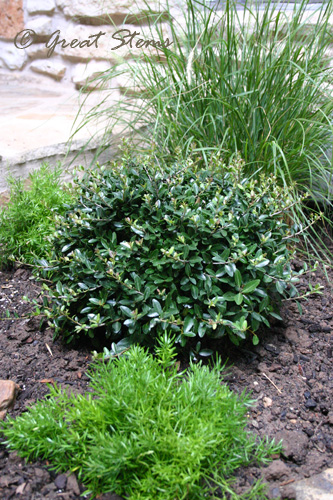
A compact Dwarf Yaupon is surrounded by Asparagus Fern.
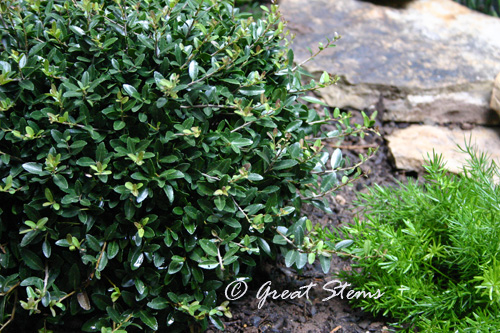
Behind them, Hameln Dwarf Fountain Grass is a nice accent, its soft plumes swaying slightly in the breeze. I hope it can handle the indirect light — it would probably prefer a little more direct sun than it is going to get. This plant isn’t evergreen, of course, but it should stay pretty nice most of the year and with luck will come back each spring.
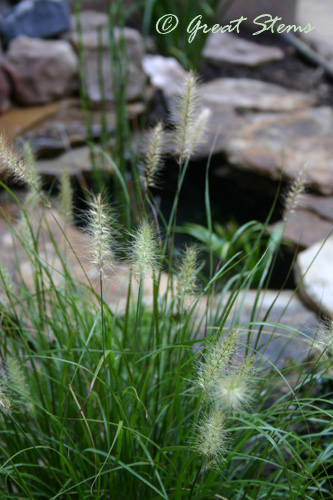 And in the pond itself, I brought Horsetail Reed from the backyard pond and an umbrella plant that needed some TLC. I also added a bit of submerged Hornwort from the backyard pond for oxygenation. We will probably add a goldfish or some other fish in a few days, so it will appreciate the grass to hide in.
And in the pond itself, I brought Horsetail Reed from the backyard pond and an umbrella plant that needed some TLC. I also added a bit of submerged Hornwort from the backyard pond for oxygenation. We will probably add a goldfish or some other fish in a few days, so it will appreciate the grass to hide in.
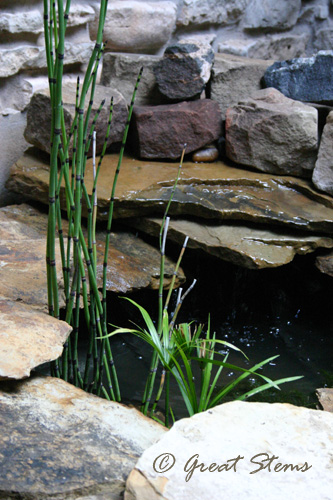 Right away we had our first wildlife visitors. Amazing what the sound of water can do. A mud dauber immediately collected little mud bits from the wet soil from the new plants. And a new butterfly appeared, choosing to collect minerals from the wet flagstone, rather than from the damp soil nearby. It’s a Tawny Emperor.
Right away we had our first wildlife visitors. Amazing what the sound of water can do. A mud dauber immediately collected little mud bits from the wet soil from the new plants. And a new butterfly appeared, choosing to collect minerals from the wet flagstone, rather than from the damp soil nearby. It’s a Tawny Emperor.
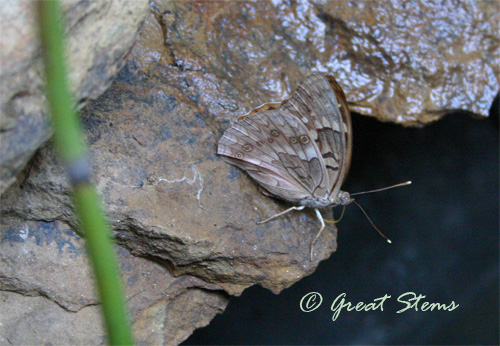 With its wings folded upright, it was almost completely camouflaged. But its beautiful tan and brown colors show through when it opens its wings.
With its wings folded upright, it was almost completely camouflaged. But its beautiful tan and brown colors show through when it opens its wings.
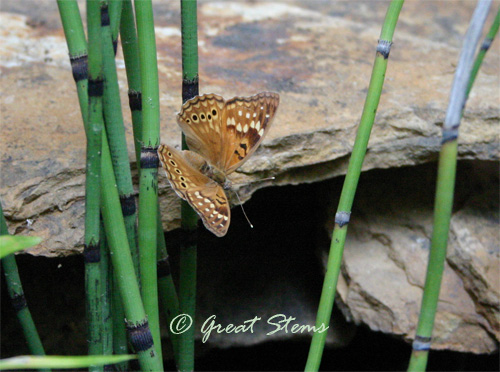 Total costs for the pond itself (I’m not including the previous pump or the new plants, just the cost of creating this one.):
Total costs for the pond itself (I’m not including the previous pump or the new plants, just the cost of creating this one.):
Tub $11 (from original fountain)
Pump (300gph) $36
Rocks — free
Liner — scrap piece — free
TOTAL $47
Easy, easy, easy.
The best part of the whole pond experience? Looking out the window throughout the day and seeing a pretty scene. Keeps a big smile on our faces, and it spreads the peace inside, too. 🙂
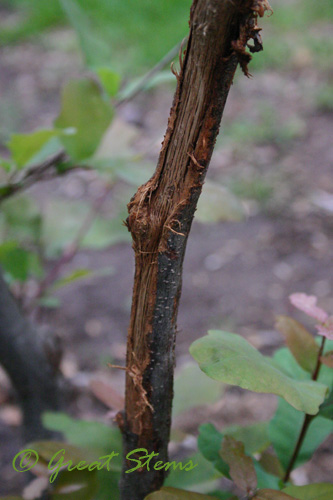
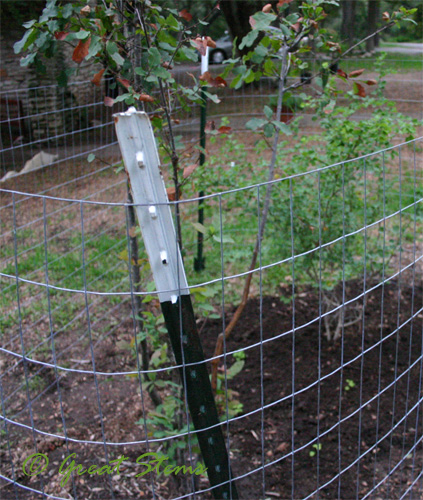
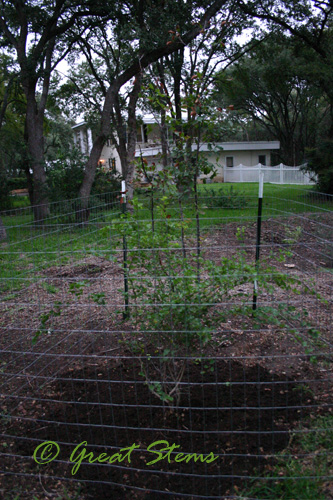 Now for some good news — the disappearing fountain is back and functioning again! We never did solve the mystery of the shifted rock, which led to the unexpected emptying of our new disappearing fountain and potential pump damage. But happily the pump still functions, and our fountain still remains the $40 disappearing fountain! We changed up the rock structure, so hopefully it will be harder for some creature to displace the tube. That little rock is only there for interest, not for directing the water flow.
Now for some good news — the disappearing fountain is back and functioning again! We never did solve the mystery of the shifted rock, which led to the unexpected emptying of our new disappearing fountain and potential pump damage. But happily the pump still functions, and our fountain still remains the $40 disappearing fountain! We changed up the rock structure, so hopefully it will be harder for some creature to displace the tube. That little rock is only there for interest, not for directing the water flow.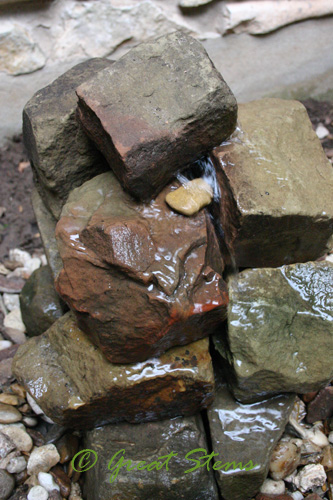
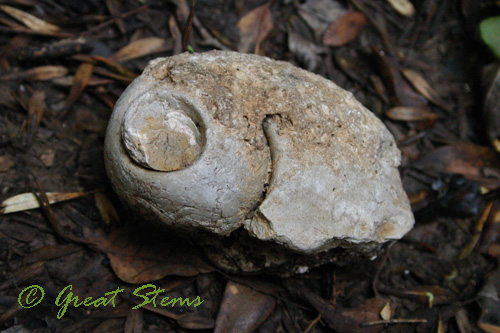
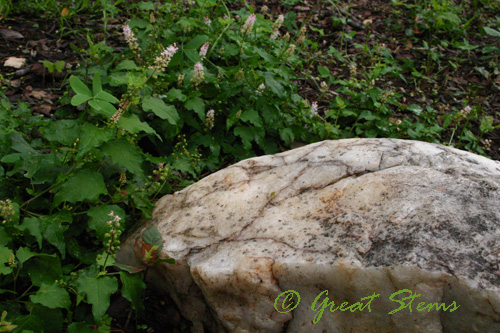
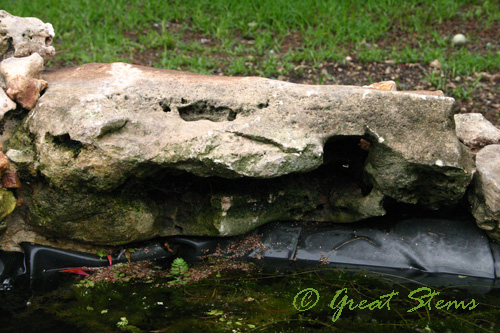
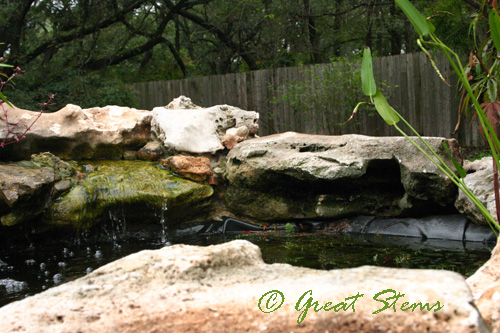 The rocks forming the back wall of the waterfall actually look like the back of an alligator — I forgot to get an angled shot to show you that a little better, but I’ll do that another time. Now I just need to figure out where to put my dwarf papyrus.
The rocks forming the back wall of the waterfall actually look like the back of an alligator — I forgot to get an angled shot to show you that a little better, but I’ll do that another time. Now I just need to figure out where to put my dwarf papyrus.